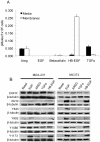Decreased autocrine EGFR signaling in metastatic breast cancer cells inhibits tumor growth in bone and mammary fat pad
- PMID: 22276166
- PMCID: PMC3261896
- DOI: 10.1371/journal.pone.0030255
Decreased autocrine EGFR signaling in metastatic breast cancer cells inhibits tumor growth in bone and mammary fat pad
Abstract
Breast cancer metastasis to bone triggers a vicious cycle of tumor growth linked to osteolysis. Breast cancer cells and osteoblasts express the epidermal growth factor receptor (EGFR) and produce ErbB family ligands, suggesting participation of these growth factors in autocrine and paracrine signaling within the bone microenvironment. EGFR ligand expression was profiled in the bone metastatic MDA-MB-231 cells (MDA-231), and agonist-induced signaling was examined in both breast cancer and osteoblast-like cells. Both paracrine and autocrine EGFR signaling were inhibited with a neutralizing amphiregulin antibody, PAR34, whereas shRNA to the EGFR was used to specifically block autocrine signaling in MDA-231 cells. The impact of these was evaluated with proliferation, migration and gene expression assays. Breast cancer metastasis to bone was modeled in female athymic nude mice with intratibial inoculation of MDA-231 cells, and cancer cell-bone marrow co-cultures. EGFR knockdown, but not PAR34 treatment, decreased osteoclasts formed in vitro (p<0.01), reduced osteolytic lesion tumor volume (p<0.01), increased survivorship in vivo (p<0.001), and resulted in decreased MDA-231 growth in the fat pad (p<0.01). Fat pad shEGFR-MDA-231 tumors produced in nude mice had increased necrotic areas and decreased CD31-positive vasculature. shEGFR-MDA-231 cells also produced decreased levels of the proangiogenic molecules macrophage colony stimulating factor-1 (MCSF-1) and matrix metalloproteinase 9 (MMP9), both of which were decreased by EGFR inhibitors in a panel of EGFR-positive breast cancer cells. Thus, inhibiting autocrine EGFR signaling in breast cancer cells may provide a means for reducing paracrine factor production that facilitates microenvironment support in the bone and mammary gland.
Conflict of interest statement
Figures







Similar articles
-
Autocrine-derived epidermal growth factor receptor ligands contribute to recruitment of tumor-associated macrophage and growth of basal breast cancer cells in vivo.Oncol Res. 2013;20(7):303-17. doi: 10.3727/096504013x13639794277761. Oncol Res. 2013. PMID: 23879171 Free PMC article.
-
Amphiregulin-EGFR signaling regulates PTHrP gene expression in breast cancer cells.Breast Cancer Res Treat. 2008 Aug;110(3):493-505. doi: 10.1007/s10549-007-9748-8. Epub 2007 Sep 20. Breast Cancer Res Treat. 2008. PMID: 17882547 Free PMC article.
-
Loss of HSulf-1 expression enhances autocrine signaling mediated by amphiregulin in breast cancer.J Biol Chem. 2007 May 11;282(19):14413-20. doi: 10.1074/jbc.M611395200. Epub 2007 Mar 15. J Biol Chem. 2007. PMID: 17363371
-
Amphiregulin as a novel target for breast cancer therapy.J Mammary Gland Biol Neoplasia. 2008 Jun;13(2):171-9. doi: 10.1007/s10911-008-9081-9. Epub 2008 Apr 25. J Mammary Gland Biol Neoplasia. 2008. PMID: 18437539 Review.
-
Amphiregulin: role in mammary gland development and breast cancer.J Mammary Gland Biol Neoplasia. 2008 Jun;13(2):159-69. doi: 10.1007/s10911-008-9075-7. Epub 2008 Apr 9. J Mammary Gland Biol Neoplasia. 2008. PMID: 18398673 Review.
Cited by
-
hsa-miR-135a-1 inhibits prostate cancer cell growth and migration by targeting EGFR.Tumour Biol. 2016 Oct;37(10):14141-14151. doi: 10.1007/s13277-016-5196-6. Epub 2016 Aug 14. Tumour Biol. 2016. PMID: 27524492
-
Epidermal growth factor signalling pathway in endochondral ossification: an evidence-based narrative review.Ann Med. 2022 Dec;54(1):37-50. doi: 10.1080/07853890.2021.2015798. Ann Med. 2022. PMID: 34955078 Free PMC article. Review.
-
Autocrine-derived epidermal growth factor receptor ligands contribute to recruitment of tumor-associated macrophage and growth of basal breast cancer cells in vivo.Oncol Res. 2013;20(7):303-17. doi: 10.3727/096504013x13639794277761. Oncol Res. 2013. PMID: 23879171 Free PMC article.
-
Parathyroid hormone-like hormone plays a dual role in neuroblastoma depending on PTH1R expression.Mol Oncol. 2019 Sep;13(9):1959-1975. doi: 10.1002/1878-0261.12542. Epub 2019 Jul 19. Mol Oncol. 2019. PMID: 31293052 Free PMC article.
-
Knockdown of AKT3 Activates HER2 and DDR Kinases in Bone-Seeking Breast Cancer Cells, Promotes Metastasis In Vivo and Attenuates the TGFβ/CTGF Axis.Cells. 2021 Feb 18;10(2):430. doi: 10.3390/cells10020430. Cells. 2021. PMID: 33670586 Free PMC article.
References
-
- Kochupurakkal BS, Harari D, Di-Segni A, Maik-Rachline G, Lyass L, et al. Epigen, the last ligand of ErbB receptors, reveals intricate relationships between affinity and mitogenicity. J Biol Chem. 2005;280:8503–8512. - PubMed
Publication types
MeSH terms
Substances
LinkOut - more resources
Full Text Sources
Medical
Research Materials
Miscellaneous

